MEANING RESTS WITHIN
By Andrew Maerkle
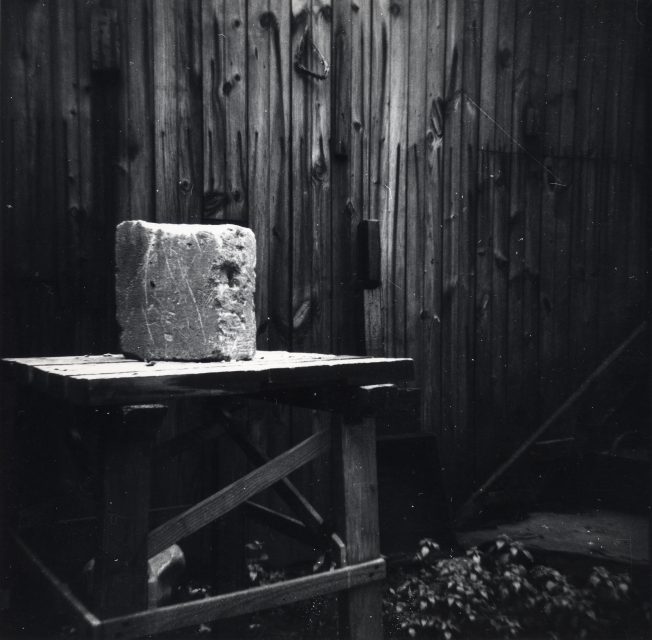 WHAT IS SET UPON THE TABLE SITS UPON THE TABLE (1962-1963), found wood, nails, screws, found limestone; table: 107 x 76 x 61 cm; stone: 61 x 61 x 30.5 cm. All images: Unless otherwise noted, © 2018 Lawrence Weiner / ARS, New York / JASPAR, Tokyo.
WHAT IS SET UPON THE TABLE SITS UPON THE TABLE (1962-1963), found wood, nails, screws, found limestone; table: 107 x 76 x 61 cm; stone: 61 x 61 x 30.5 cm. All images: Unless otherwise noted, © 2018 Lawrence Weiner / ARS, New York / JASPAR, Tokyo.
Born in New York in 1942, Lawrence Weiner has been at the forefront of contemporary art for over five decades now. Working in the medium of “language + the materials referred to,” he is credited as one of the originators of conceptual art, but his protean output defies categorization: Weiner in fact refers to himself as a sculptor, and he also makes artist books, multiples, music, films and other collaborative projects. He outlined the principles of his work in his “Statement of Intent,” first published in 1968 and subsequently revisited on numerous occasions:
1. The artist may construct the piece.
2. The piece may be fabricated.
3. The piece need not be built
Each being equal and consistent with the intent of the artist, the decision as to condition rests with the receiver upon the occasion of receivership.
These principles establish a fundamental generosity in the work: Weiner says that viewers are free to use the work “to meet their own needs and desires”; moreover, the “Statement of Intent” also suggests that, although each installation of a work may have a site- or context-specific aspect, viewers are in a sense free to take the work home with them, whether as remembered in their minds or jotted down in a notepad.
Weiner has participated in several projects in Japan over the course of his career, including the survey “Revolution: Art of the Sixties from Warhol to Beuys,” held at the Museum of Contemporary Art Tokyo in 1995; a series of solo exhibitions in the 1990s at Gallery 360ᵒ in Tokyo; a residency at CCA Kitakyushu that resulted in an artist book, Apples & Eggs, Salt & Pepper (1999); and, more recently, group exhibitions the Dojima River Biennale, held in Osaka in 2013, and the Okayama Art Summit, held in Okayama in 2016. He returned to Tokyo at the start of this year for an exhibition of new works at Taro Nasu Gallery, “WATER & SOME OF ITS FORMS.”
To mark the occasion, ART iT caught up with Weiner at his studio in New York following the opening of the exhibition.
“WATER & SOME OF ITS FORMS” was held at Taro Nasu Gallery, Tokyo, from January 13 to February 10, 2018.
Interview:
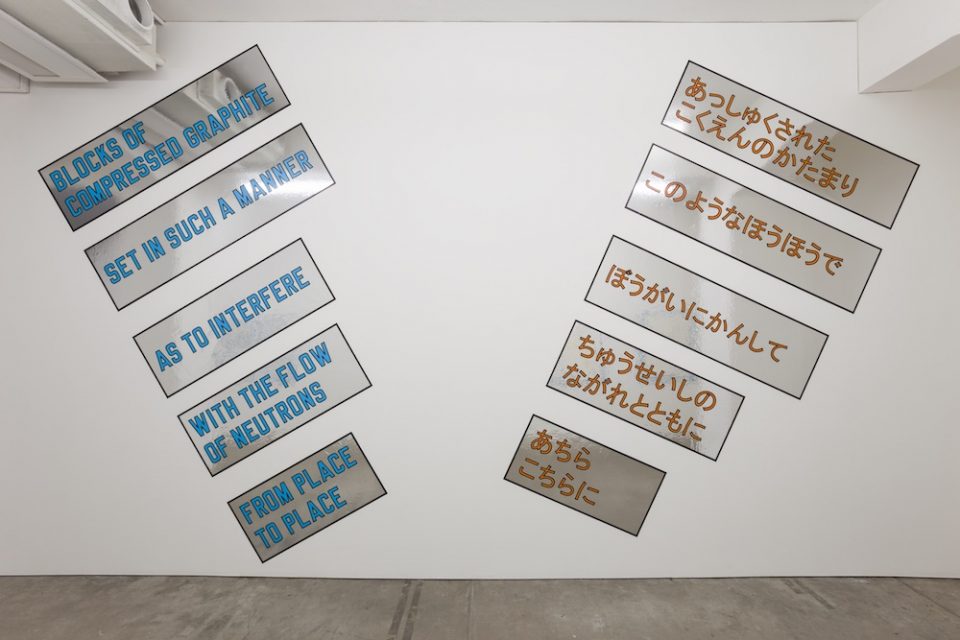
Installation view of “WATER & SOME OF ITS FORMS” at Taro Nasu Gallery, Tokyo, 2018. Photo Kei Okano, © Lawrence Weiner, courtesy Taro Nasu.
ART iT: Is it possible to take language out of context? The question seems to me to be tied to the idea of an emancipatory philosophy: because couldn’t we say that on some level to be out of context is to be emancipated?
LW: I see where you’re going with that. I don’t know if you can. The context is always there. But when the context becomes the subject – forget it! Then it becomes silly graduate-student art. It’s all been done before and it’s not going anywhere, but it’s very important that you have a certificate that says you’re not going anywhere.
I think there is a context-and-content problem here. That’s why I’m not a great fan of Duchamp. It wasn’t that Duchamp was wrong. I liked him personally. He lived on 14th Street, and at the time, in the 1950s, he had the same habits as everyone in the whole area. He smoked dope, did everything everybody else did. He and Franz Kline even got along. Kline was also on 14th Street. You wouldn’t think they would get on together, but they did – they were honest people.
But what happened is that the graduate-student types took over Duchamp and they didn’t get it. They didn’t get that he was an old-fashioned artist. He was smart, but he was old-fashioned. He believed in the maître, the master.
He was such a sweet man, by the way. I used to meet him once every couple of months or so. I lived on Bleecker Street around the corner from Bob Rauschenberg. Or, rather, Rauschenberg lived around the corner from me, since I was there first. In any case Rauschenberg had a good relationship with Duchamp.
ART iT: Did Duchamp mean anything to you then?
LW: Yes, I really loved certain things of his. But I’m a strange case. I came to the art world from the left rather than the right. I was an organizer for civil rights and other political movements. Then I realized that if you want to change the world, the way to do it is to change the culture – but not individually, not by being a hero or by screaming and yelling. I adored Leon Golub, but that was his problem: it was “Me, me, me, me. I’m doing it.” No, no, no. It’s happening, and it would happen whether you did it or not – but if you did do it, then you would be better off than the others.
There’s a story I like to tell about Sartre, who was selling papers on the street for L’Humanité. Someone came to him and said, “You know, you’re too famous. You can’t be doing this.” Sartre’s reply was “From seven in the morning to noon, when I’m working on my Flaubert book, I may be the best litterateur in France. But from then on, I’m just a citizen – and isn’t it lucky that the left can attract someone as talented as I am to sell papers for them?”
That is the most profound thing anybody has ever said. You have a right to have an opinion if you do something, whether it’s making shoes or washing dishes. If you don’t do anything in society, if you’re just like the Trump people, and all you do is take – that’s when you don’t have a right to talk. But expressing your opinion doesn’t mean that you stop making the work you’re making.
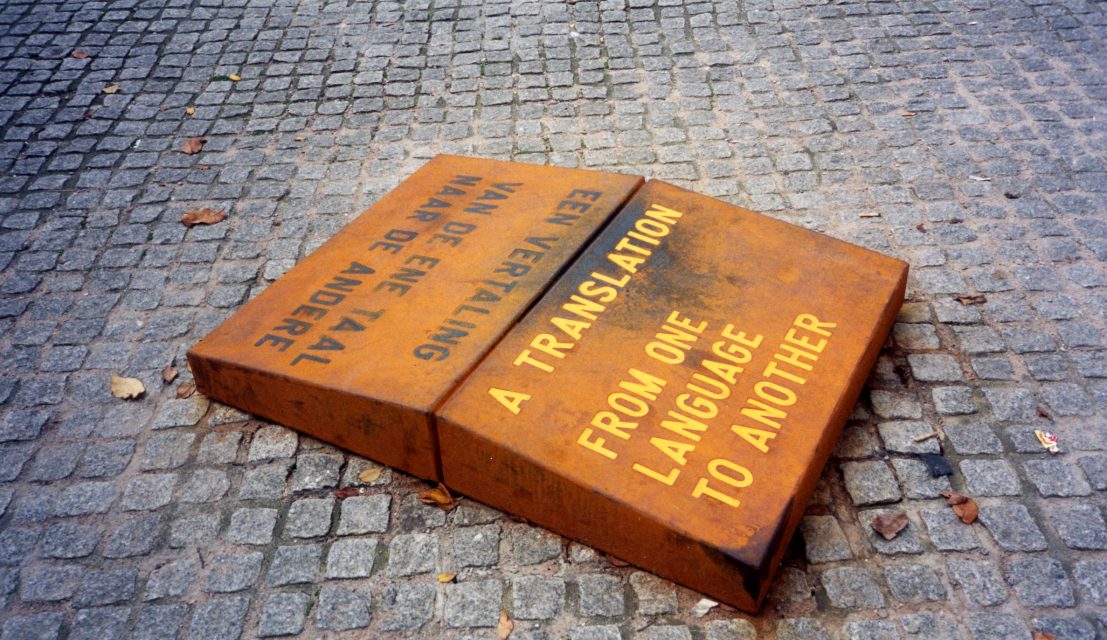
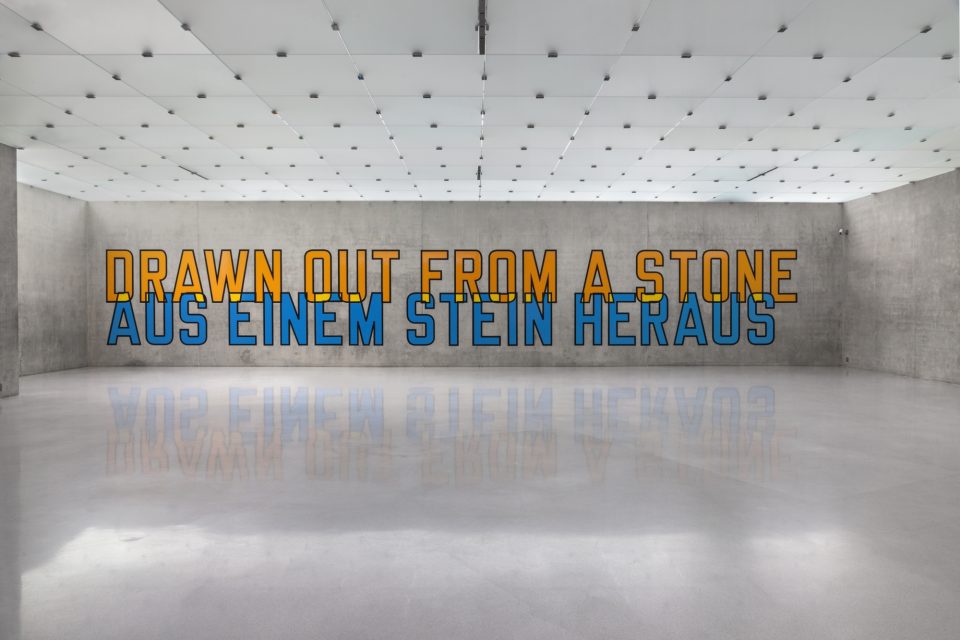
Above: A TRANSLATION FROM ONE LANGUAGE TO ANOTHER (1969), public installation, Het Spui, Amsterdam, 1996. Below: DRAWN OUT FROM A STONE (2016), installation view in “Lawrence Weiner: WHEREWITHAL | WAS ES BRAUCHT,” at Kunsthaus Bregenz, 2016. Photo Rudolf Sagmeister.
ART iT: So for you the turn to language as sculpture –
LW: Became a necessity. Once I realized that when you painted in the studio, all you were doing was objectifying what you were trying to present, it became obvious to me that language would work the same as any other material. But the meaning, and not the structure of language. So stone became stone, without any double meanings. It was not, “On this stone I will build my church.” No, it was just stone.
ART iT: Is language then a placeholder for the idea?
LW: Placeholder? Sure, it makes room. It holds it. But the whole point of making a work of art is that if you look at it, you have to describe it in your mind. In describing it in your mind, what are you using? Language. Why not take it for granted that the majority of the people you’re meeting are just as smart as you, and can understand what the word means? Then you’re free and clear. I still believe that. And it seems to work. What can I say?
ART iT: What does each individual work do to change the culture?
LW: It presents an object with care. It presents an object that sits out in the middle, and from that people can then figure out how to use it to meet their own needs and desires. That’s all art does for anybody. A Van Gogh or a Picasso only lets somebody look at something, and as long as it’s not an overly emotional work, viewers can put themselves into it and use it. That’s what my favorite painter Caspar David Friedrich does. He has no metaphor in his paintings. If you can leave out metaphor, art becomes far more universal.
As far as translations go, I mean, gee whiz, it’s like a reproduction. There are lousy reproductions of things and there are decent reproductions – but it’s still a reproduction of the same thing.
ART iT: But you’ve done works that seem to intentionally play with translation and juxtaposing different languages.
LW: You say that, but it’s so rare. You brought up AN DIE SEE / AN DEN SEE (TO THE SEA / TO THE LAKE) in the questions you prepared. In German, you change the gender of the sea and it switches the meaning from salt to fresh water. I did a whole book and show about that years ago. It’s not magic, it’s just the way you perceive it. If you read German, then you know which is fresh and which salt water. If you don’t read German, then it’s just another transliteration and you’re still just talking about water. So by the sea, bordering the sea – unless you’re interested in drinking it, it doesn’t much matter whether the water is fresh or salt.
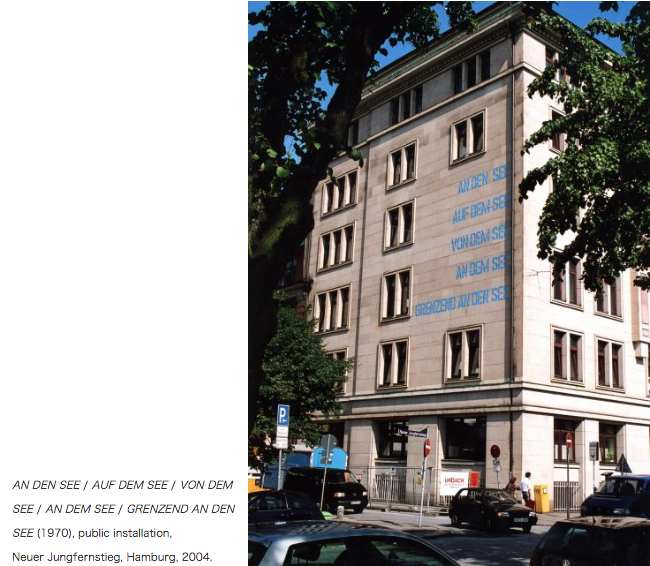
ART iT: Yet there are also cases where the work seems more complete in one language than another, such as WAT OP DE TAFEL STAAT STAAT OP DE TAFEL (WHAT IS SET UPON THE TABLE SITS UPON THE TABLE).
LW: That was an aggression on my part for my retrospective at the Stedelijk Museum in 1988. The class system in Holland bothers me. I’m outside of it, so it’s not a personal thing, but it bothers me. The words in the work are working-class Dutch. It’s the kind of thing that a Hells Angels-type with nothing to lose might say. I made a record with Coosje van Bruggen about it. Every once and a while there’s something like that. But it’s like green and yellow and blue. In China yellow has connotations of death, whereas in Japan it’s just yellow.
So every once in a while the meaning of something in a local context can complete the work, and it helps to know it, but you don’t have to know it to appreciate it or use it. That’s the point. The work should never require somebody having to go and look it up.
ART iT: You’ve talked before about multiple realities; one thing translation does is to open up multiple realities.
LW: It opens the door for people who don’t speak your language to possibly get a comprehension and a use out of what you make. I’m usually careful to make sure that anything that’s shown is shown in the language of where it is presented. But you have to trust people a bit on the translation. You can’t know everything. Depending on your background you might know two or three languages – I can speak French, German and Dutch – but the problem is you begin to realize as you get older that you don’t speak them well. I don’t, at least. But I’m comfortable with that.
ART iT: People often make the mistake of obsessing over perfecting their language.
LW: Language is a constantly evolving entity. I try to make everything such that you don’t have to know anything when you encounter the work except how to read. And you don’t even have to know how to read, because everything means something, so you just build it yourself.
People are much more intelligent about it than the academy is. When they see my work, they might say things like “That’s strange,” but they’re not upset by it. It’s the academy that has a problem. The purpose of the academy is to present answers, or, at least, solutions. The purpose of art is to ask questions. They’re not the same. You cannot be an art teacher and also an artist. It does not work. A teacher has to have authority. As an artist you teach because you need the money, and you try to do as little damage as you can. That’s what doctors say: Do the least amount of harm.
But as far as the context and content thing, I think I’m just tired of that conversation. It’s been going on since I entered the art world in the 1950s. Oh, God! Context and content, context and content! We’ve now got a life where context and content are completely mixed up because of advances in technology and all that.
What’s set on the table sits on the table. Wat op de tafel staat staat op de de tafel. Dutch is a funny language. I like it. It’s pretty.

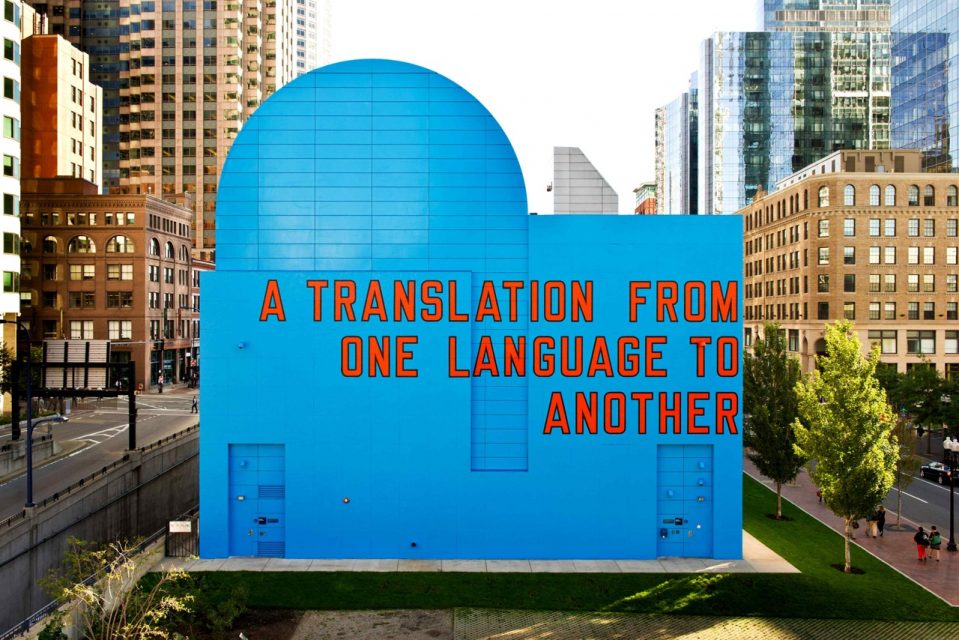
Above: OUTSIDE OF ANY GIVEN CONTEXT (2010), installation view in “Liam Gillick and Lawrence Weiner: A Syntax Of Dependency,” MuHKA, Antwerp, 2011. Photo Bram Goots. Below: A TRANSLATION FROM ONE LANGUAGE TO ANOTHER (1969), installation view, Rose F. Kennedy Greenway Mural, Boston, 2015. Photo Geoff Hargadon.
ART iT: What about a project like “Syntax of Dependency,” made in collaboration with Liam Gillick at M HKA in 2011, where the presentation of English, Flemish and French in the same space could be seen as a reflection of the particular context in Belgium – a country that is in fact socially and politically divided between two languages, Flemish and French?
LW: Syntax is the problem. The reason why more people do not accept art as a way to look at the world is that they think the syntax of art goes against their ethics. Look at Trump. His administration is a classic example of what happens when the academy takes over syntax. What surprises me is the filthiness of the language these people are using. I see it in the news. Presidents do not use the word asshole. And when someone like Trump begins to question the reading ability of his chief of staff – John Kelly, a retired general – then you know there’s something wrong!
I think the question of whether art can be presented in language or not is a moot point. We’ve accepted happily that you can make sculpture from sound, or from light, or from air, as Ryan Gander did at documenta in 2013. So why does everybody get upset when you say you can use language? I’m 76 years old, I did my first show when I was 18, and they’re still questioning whether it’s art or not. When I look at the newspaper articles about my exhibitions, it’s the same whether it’s in Canada or in Holland: “What is this? This isn’t art, it’s language! It’s this! It’s that!” Very strange, isn’t it? Maybe that’s proof I got it right? Maybe I really did strike a nerve?
ART iT: Where do you think the distrust of contemporary art comes from?
LW: Need. Cultures that have a need to understand the physical world around them with some kind of moral precept seem to develop a highly structured idea of art. There are cultures that have no need to structure it. They’re not against it, they’re not for it. They don’t care. It doesn’t affect them. Something else does.
But art comes from need. You have to find your place in the sun or else you don’t get any heat. And if you don’t get any heat from the sun, you freeze. Well, unless you can use art to understand your relationship to the world, you freeze.
My interest in art was always that if you can present a decent relationship between yourself and a cobblestone, you basically have elevated everything to another level. When you make art it makes you a better person. It may sound sentimental, but when I say it to kids in a workshop, they look up and it makes sense to them.
It’s almost like Escoffier, the chef who changed all the rules for modern haute cuisine. Escoffier believed that if you could cook an egg correctly, you probably could solve the world’s starvation problem. But nobody could do it consistently. His dream was to make it consistent – because it turned out he was not that great of a chef, and he lived mostly on scrambled eggs. As most chefs do! That was a real shock for me to find out.
There was a sushi chef in Tokyo who taught me how to use a knife properly. He said, do you trust me? So we smoked a joint and then he showed me how to do it. The truth is you can change the taste of anything by how you cut it. Art is the same way. That’s what makes good artists and bad artists. Bad artists believe that what everybody told them is the thing to do, and that’s where they get in trouble. Good artists don’t believe it. A good artist does not use the standard solutions. That’s what art is about. Aside from the economics, being an artist is one of the freest things in the world. You’re not flying an airplane; you’re not writing a prescription. It doesn’t matter if you fuck up. That’s why I like Mondrian. He tried very hard not to make mistakes, but when he did make a mistake, he just moved on.
ART iT: But where does that leave the artist in relation to the institutional structures of art?
LW: I see making art as a moral choice. A lot of people don’t. A lot of people see it as a professional choice, a cultural choice. I see it as a moral choice. That’s why, when the language alone was not working as well as I wanted, I began to incorporate into the work gestures and punctuation, which had their own meaning, and it seemed to develop quite nicely.
I’m lucky that what I was doing went against everything the authorities believed in. People always tell you about all the rules they broke when they were children, and how that made them special, but then when they have their own child, they force the child to do everything according to the rules of the dominant culture. Well, art can avoid that, but the art schools can’t. There has to be a subject for a teacher to teach. In order to be in the academy, you have to be an authority. There’s no reason for it, but they do it, and they force it upon others. They ruin people. In the sixties I needed the 125 dollars they’d pay me, so I’d give a lecture somewhere, and you’d look at the audience and realize that they believe you’re an authority. There’s no way you could tell them that you’re just thinking off the top of your head: you’re an authority. And I don’t want to be an authority. I don’t want to ever, ever, ever have a relationship with someone who wakes up in the morning and asks, “Was it as good for you as it was for me?” That’s not the end product of a life. I’m serious!
Things are supposed to be on the table. They’re supposed to be obvious. And most art is. Even with the most obscure artist – Boetti for example – if you stand still and give it enough time, no matter who you are, you can find a rationalization for understanding the work. If you stick with “it doesn’t fit, it doesn’t fit,” you’ll never understand it. It’s like learning to drive an automobile while still holding the reins of the horse. You can’t drive an automobile and hold on to the horse at the same time. So the recent work that I’ve been doing interests me because I’m surprised that it enters the culture so easily. It’s not accepted as such, but it enters.
No matter who you are, you come from somewhere and you find a club you want to join, but you have to get them to even notice you before they can accept or reject you. So you assume a position. And if you get in, you have to realize that you’re making presumptions about what’s actually inside, because you have no way of knowing from the outside. It’s about presuming and assuming. And then once you’re in, if you’re smart, you won’t try to be like them, you’ll try to be like who you are, and either it’ll fly or it won’t.
Art is the same thing. It either flies or it doesn’t fly. And you almost don’t quite know why. It has to do with a confluence of things. The work that I was doing for years has had an influence on the culture, and I’m very proud of that, but there’s nothing worse than running around with the same red flag. Reject it if you want. I’m not happy when people reject it, but so what? There’s not much I can do about it.
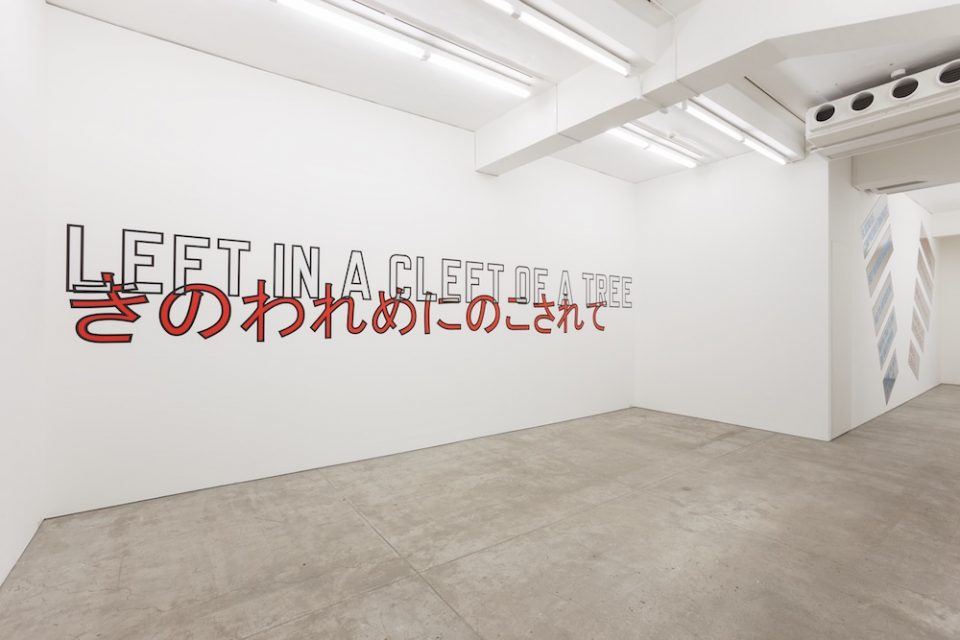 Installation view of “WATER & SOME OF ITS FORMS” at Taro Nasu Gallery, Tokyo, 2018. Photo Kei Okano, © Lawrence Weiner, courtesy Taro Nasu.
Installation view of “WATER & SOME OF ITS FORMS” at Taro Nasu Gallery, Tokyo, 2018. Photo Kei Okano, © Lawrence Weiner, courtesy Taro Nasu.
ART iT: What happens when people misunderstand or misread it?
LW: As long as they don’t misuse it, and they don’t use it to do somebody in, then I usually don’t say a word. Why should I? There’s no real interpretation of anything. The color pink: What does it mean? You can’t get it wrong. You might not get it right, but you won’t get it wrong either.
It’s like cooking an egg. It might not look really good, and it might not taste that good, but it’s cooked. When you get it right, it’s a delight. And art, when you get it right – even when it’s violently against the existing structure – is a delight. It is a total, absolute delight. It’s a liberator for young people when they see that you’re noticing that something has to be on top in order for something to be on the bottom. That becomes a major, major philosophical thing for them.
I don’t want to teach anybody how to make art. I don’t even want to tell them to make art. I’ll explain that an artist exists because you have something to say and then you have to try to find a way of saying it that can enter the culture. That’s all art is. It’s the attempt to say something. Because if you’re not saying anything, then what’s the point? And I like people’s lives to have a point. I’m not a humanist or anything, but I do believe in human dignity.
ART iT: How do you understand the paradox that contemporary art is simultaneously anti-authoritarian and authoritarian?
LW: Yes, one moment it’s holding up a class structure that you find abhorrent, and the next it’s holding up a class structure that you find quite enviable. Why can’t you have a conundrum? Why can’t you be the one responsible for how to use it?
Lawrence Weiner: Meaning Rests Within
